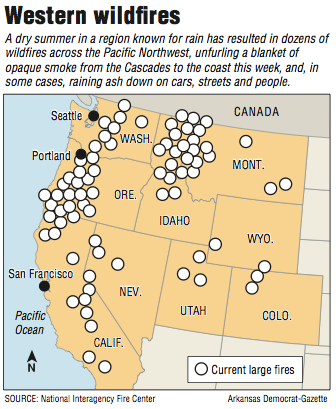DENVER -- Wildfires are chewing across dried-out Western forests and grassland, putting 2017 on track to be among the worst fire seasons in a decade.
In many major western U.S. cities, yellow smoke clogs the skies. A human-caused fire in the Columbia River Gorge has rained ash on Portland, Ore., and at Glacier National Park in Montana, a century-old backcountry chalet burned to the ground.
A snowy winter across much of the West raised hopes that 2017 wouldn't be a dried-out, fire-prone year, but a hot, dry summer spoiled that.
The heavy snows provided relief from a long, brutal drought across much of the West and produced a lush growth of natural grasses -- thicker and taller than many vegetation experts had ever seen. But the weather turned very hot very fast in the spring, and the snow melted much faster than expected.
All the grass that grew high dried out, and so did forests at higher elevations, leaving plenty of fuel for wildfires, said Bryan Henry, a manager at the National Interagency Fire Center, which coordinates wildfire-fighting.
Summer lightning storms then dumped less rain than usual, and weather conditions kept the humidity low, creating a natural tinderbox in many states.
"It was kind of a bad combination of things," Henry said.
By Thursday, more than 76 large fires were burning in nine Western states -- including 21 in Montana and 18 in Oregon, according to the interagency fire center.
So far this year, wildfires have burned more than 12,500 square miles nationwide. In the past decade, only two years were worse at this point in the wildfire season: 2015 and 2012.
For all of 2015, a record 15,800 square miles burned. In 2012, 14,600 square miles were scorched.
The fires have destroyed an estimated 500 single-family homes and 32 commercial buildings this year, according to the interagency fire center.
Climate change is making things worse for fires, said Jonathan Overpeck, dean of the School for Environment and Sustainability at the University of Michigan.
Hotter and drier weather is a symptom of human-caused climate change, and that's making fires worse by leaving forests and other vegetation more flammable, he said.
"It's not, of course, playing the only role," he said. "There's natural variability at work."
"Humans are contributing to an ever-increasing degree to wildfires in the West as they emit greenhouse gases and warm the planet and warm the West," Overpeck said.
More than 26,000 people are fighting the fires, supported by more than 200 helicopters, 1,800 trucks and 28 air tankers dropping water and fire-retardant slurry. Three of those tankers are military C-130 planes.
The military has also assigned surveillance aircraft and at least 200 active-duty soldiers to fight fires and the National Guard has been called out in at least four states: California, Montana, Oregon and Washington.
"We're stretched thin," said Jennifer Jones, a spokesman for the interagency fire center.
Nine firefighters have died and 35 have been injured this year, the Wildland Fire Lessons Learned Center said. Two of the deaths occurred during training.
The smoke, meanwhile, is "unusually bad," Henry said.
It's lingering from Northern California and central Nevada to Montana. The air over parts of Northern California, Idaho, Montana, Oregon and Washington is rated very unhealthy on the U.S. Environmental Protection Agency's AirNow website. It was not clear whether sources other than fires were contributing to that.
The air over the towns of Cottonwood and Porthill, Idaho, were listed as hazardous, the worst of six categories.
Fires spew particulates into the air, which are linked to premature death and cancer, and can make asthma and chronic lung disease worse, said Norman Edelman, a senior science adviser to the American Lung Association.
"It certainly is bad enough to cause symptoms in people with chronic lung disease but also normal people," he said.
The outlook for relief is bleak for Montana, most of the Northwest and much of California through September, the interagency fire center said. The fire risk is expected to remain high in Montana and the Southern California coast through October.
Montana is in the grip of a long, severe drought. Nearly a quarter of the state, near the northeast corner, is rated as in a state of exceptional drought, the worst of five categories on the federal government's U.S. Drought Monitor.
Information for this article was contributed by Matt Volz and Andrew Selsky of The Associated Press.
A Section on 09/09/2017
